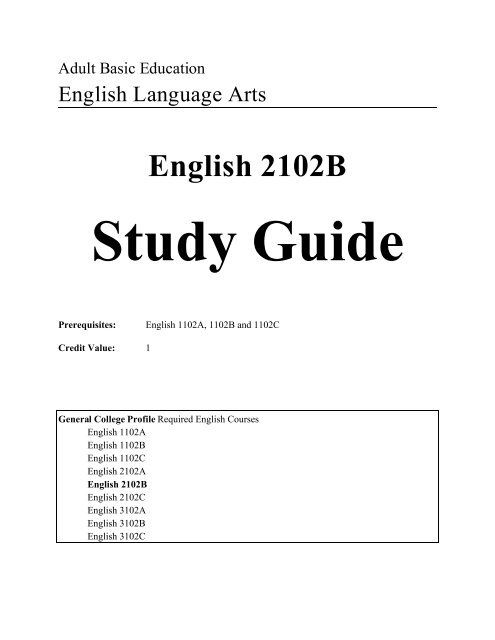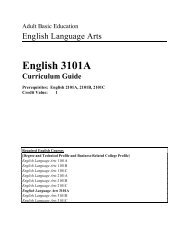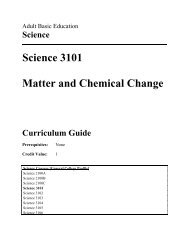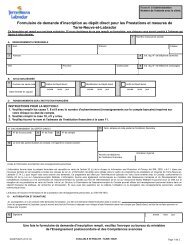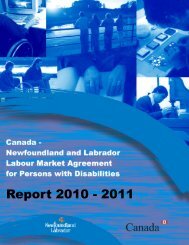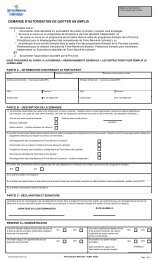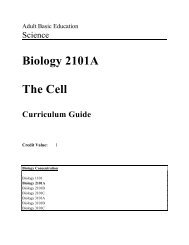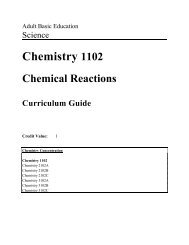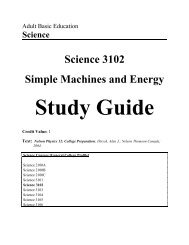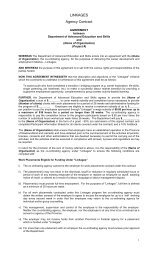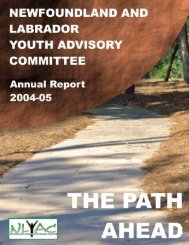English 2102B Study Guide 2005-06
English 2102B Study Guide 2005-06
English 2102B Study Guide 2005-06
You also want an ePaper? Increase the reach of your titles
YUMPU automatically turns print PDFs into web optimized ePapers that Google loves.
Adult Basic Education<strong>English</strong> Language Arts<strong>English</strong> <strong>2102B</strong><strong>Study</strong> <strong>Guide</strong>Prerequisites:<strong>English</strong> 1102A, 1102B and 1102CCredit Value: 1General College Profile Required <strong>English</strong> Courses<strong>English</strong> 1102A<strong>English</strong> 1102B<strong>English</strong> 1102C<strong>English</strong> 2102A<strong>English</strong> <strong>2102B</strong><strong>English</strong> 2102C<strong>English</strong> 3102A<strong>English</strong> 3102B<strong>English</strong> 3102C
Table of ContentsTo the Student ...............................................................5Unit 1Unit 2Unit 3Short Non-Fiction and Related Writing .......................................7Non-Fiction Book and Related Writing ......................................11Written Communications and Writing Conventions ............................13Texts:Anthologies:Between the Lines 11Between the Lines 11 CD SetLand, Sea, and Time, Book TwoReference Books:Communicate!<strong>English</strong> <strong>2102B</strong> <strong>Study</strong> <strong>Guide</strong> Page 3
To the StudentThe following questions and answers should help you use this <strong>Study</strong> <strong>Guide</strong>.Who should do <strong>English</strong> <strong>2102B</strong>?<strong>English</strong> <strong>2102B</strong> is intended for those who are studying in the General College Profile of AdultBasic Education.What is in the <strong>English</strong> <strong>2102B</strong> <strong>Study</strong> <strong>Guide</strong>?The <strong>English</strong> <strong>2102B</strong> <strong>Study</strong> <strong>Guide</strong> describes all the work that is required for the completion of thiscourse. There are 3 separate Units in this course - they are listed in the Table of Contents.How Should I Use the <strong>Study</strong> <strong>Guide</strong>?Before beginning to do the work in this <strong>Study</strong> <strong>Guide</strong>, you will need to talk to your instructorabout the course and the resources you will need to complete the work for the course.The <strong>Study</strong> <strong>Guide</strong> provides important information and guidance which you will need to complete<strong>English</strong> <strong>2102B</strong>. You should work through the <strong>Study</strong> <strong>Guide</strong> page by page, consulting with yourinstructor as you go.How is the <strong>Study</strong> <strong>Guide</strong> organized?The <strong>Study</strong> <strong>Guide</strong> is organized in two columns, as follows:Required WorkThis column provides a numbered list of allthe work you are required to do for thecourse.You should note that there are 3 separateUnits in the course and the Required Workfor each Unit starts with the number 1.<strong>Guide</strong>lines and SuggestionsThis column gives you important informationand guidelines to help you complete theRequired Work in the left-hand column.You should always read this column beforebeginning the Required Work.Important NoteThis <strong>Study</strong> <strong>Guide</strong> is intended to make it possible for you to work independently in the AdultBasic Education class. If you use the <strong>Guide</strong> correctly, you may be able to work on your own forcertain periods of time. You should always make sure that your instructor is aware of what youdoing, however, and you should feel free to ask your instructor for help and guidance at all times.<strong>English</strong> <strong>2102B</strong> <strong>Study</strong> <strong>Guide</strong> Page 5
Unit 1Short Non-Fiction and Related WritingRequired WorkLearning About Types of Non-Fiction1. In preparation for reading short non-fiction,you should define the following types of nonfictionand discuss them with your instructor:•essay•biography•autobiography•memoir•interview•profile•editorial•article (newspaper or magazine)•textbook<strong>Guide</strong>lines and SuggestionsNon-fiction is text that has factual informationabout something or that tells about things asthey actually happened. This is in contrast tofiction - in which people, events and stories aremade up from the writer’s imagination. Somewriters of fiction base their stories on realpeople or real events, so it may be difficultsometimes to tell the difference betweenfiction and non-fiction. However, most nonfictionis straightforward and you know thatthe information or events are factual. Forexample, newspaper articles, interviews,profiles, and textbooks are all clearly definedexamples of non-fiction.You may find definitions of the different typesof non-fiction in a number of places,including:• dictionaries• glossaries of your literature reference booksand anthologies• Internet web sitesYou may need to ask your instructor forassistance in defining some of these terms.You should discuss your definitions with yourinstructor in all cases.2. Identify and examine examples of at least 5different types of non-fiction.Your anthology, Between the Lines 11, may beused for this exercise as it contains manydifferent types of short non-fiction. This willalso help you in selecting non-fiction texts toread later in this Unit.<strong>English</strong> <strong>2102B</strong> <strong>Study</strong> <strong>Guide</strong> Page 7
Unit 1Short Non-Fiction and Related WritingRequired WorkListen3. Listen to the recorded magazine article, “LetMe Tell You about the Crime I Committed”,by Sallie Tisdale on the Between the Lines 11CD (Disk 1, Track 7).Read, Discuss and Write4. Read “Let Me Tell You about the Crime ICommitted” (Between the Lines 11, pages 110-112).4.1 Discuss “Let Me Tell You about theCrime I Committed” in a small group or withthe instructor4.2 Answer question 1 on page 112.4.3 Write a brief response to one thefollowing statements:•We all steal at some level.•We are all guilty of slights towards others.•Small “crimes” have a significant impact onothers, of which we are often unaware.•People frequently do not know or understandtheir own destructive impulses.<strong>Guide</strong>lines and SuggestionsListen to “Let Me Tell You About the Crime ICommitted” and read it at least twice to makesure that you fully understand the author’smessage.Your instructor may arrange for you to discussthis article. If there are others reading thearticle at the same time, you may be requiredto participate in a small group discussion. Ifnot, you may discuss the article with yourinstructor.You should note that, in the questions(Required Work 4.2 - 4.3), the word “crime”is in quotation marks. You should considerwhat this means in relation to the article - thatthe “crimes” the author discusses are notconsidered crimes in terms of the law.Quotation marks used in this way should alertyou to the fact that the word is being used in aspecial way. In your answers to the questions,you will need to keep this special meaning forthe word “crime” in mind.Your answers to all questions should bewritten in short essay style. You should editeach answer to ensure that it is coherent andthat there are no mistakes in grammar,punctuation or spelling.Page 8 <strong>Study</strong> <strong>Guide</strong> <strong>English</strong> <strong>2102B</strong>
Unit 1Short Non-Fiction and Related WritingRequired WorkRead, Analyze and Write5. Select and read at least 3 other short nonfictiontexts from Between the Lines 11. Eachselection should be a different type of nonfiction.There are four non-fiction texts recorded onthe Between the Lines 11 CD in addition to theone you have already listened to. If any of thetexts you select to read is recorded, you maylisten to it as well. The four recorded nonfictiontexts are:• “The Ordinary Superstar: Wayne Gretzky”,Disk 1, Track 5 (profile)• “Debating the Death Penalty”, Disk 2, Track1 (2 essays)• “Arctic Plums”, Disk 2, Track 2 (memoir)• “One Woman’s Story”, Disk 2, Track 4(essay)<strong>Guide</strong>lines and SuggestionsYou should check the table of contents ofBetween the Lines 11 to locate non-fictiontexts. The type of non-fiction is indicated inbrackets after title and author. You will findmany different types of non-fiction text,including the following:•essays•editorials•profiles•interviews•articles (magazines and newspapers)•memoirs•instructionsYou are required to choose 3 different types ofnon-fiction. For example, you might choose toread an essay, a memoir and an interview.You have already read a magazine article(Required Work 3 and 4).5.1 Answer questions, assigned by yourinstructor, on each text selected.Your instructor will assign questions on eachof the texts you select and read.Your answers to all questions on the nonfictionselections should be written in shortessay style. You should edit each answer toensure that it is coherent and that there are noerrors in grammar, punctuation or spelling.<strong>English</strong> <strong>2102B</strong> <strong>Study</strong> <strong>Guide</strong> Page 9
Unit 1Short Non-Fiction and Related WritingRequired WorkSelect, Read and Write6. Select and read one non-fiction text fromLand, Sea and Time, Book Two.<strong>Guide</strong>lines and SuggestionsThe Land, Sea and Time books providereading material, including short non-fiction,about the Newfoundland and Labrador heritageand culture. You may skim the whole of BookTwo to find a short non-fiction text of interestor special significance to you. You will need todecide whether a particular text is fiction ornon-fiction before making your selection, sincethe Land, Sea and Time books are notorganized by genre. You may ask yourinstructor for guidance with your selection.Here are some short non-fiction selectionsfrom Land, Sea and Time, Book Two that maybe of interest to you:• “To See Things and to Understand” by LydiaCampbell (page 23)• “Personal Account of Attending BoardingSchool in Muddy Bay” by Millicent BlakeLoder (pages 25-27)• “Marriage” by Hilda Chaulk-Murray (pages131-135)• “Mosey” by Donald Gale (pages 108-110)• “Call Me an Indian: The Calvin White Story”by Chris O’Neill-Yates (pages 73-76)6.1 Answer questions, assigned by yourinstructor, on the selected text.Your instructor will assign questions on thetext that you select and read.Your answers to all questions on the nonfictionselections should be written in shortessay style. You should edit each answer toensure that it is coherent and that there are nogrammar, punctuation or spelling errors.Page 10 <strong>Study</strong> <strong>Guide</strong> <strong>English</strong> <strong>2102B</strong>
Unit 2 Non-Fiction Book and Related WritingRequired WorkSelect, Read and Discuss1. Select and read a non-fiction book from alist provided by your instructor.<strong>Guide</strong>lines and SuggestionsYou should select a book based on personalinterest. In order to make a selection from thelist of books provided, you should do someresearch. You should start by reading anyinformation available with the book (reviewsor comments on the cover of the book, thepreface, the introduction, etc.). You may alsofind a description of the book in the library oron the Internet—or you may find out about thebook by talking to others who have read it.You may also choose to read a few pages frommore than one book before making your finalchoice.1.1 Discuss the book with your instructor or ina small group organized by your instructor.Write2. Answer questions, assigned by yourinstructor, on the book.Your instructor will arrange for you to discussthe book. If there are others reading the bookat the same time as you are, you may berequired to participate in a group discussion.If not, you may discuss the book with yourinstructor.Your instructor will assign questions on thebook. Your answers should be written in shortessay style. You should support your answersby referring to the book.You should edit each answer to ensure that it isclear and that there are no grammar,punctuation or spelling errors.<strong>English</strong> <strong>2102B</strong> <strong>Study</strong> <strong>Guide</strong> Page 11
Unit 2 Non-Fiction Book and Related WritingRequired WorkWrite a Book Report3.Write a short book report (two typewrittenpages, double-spaced).<strong>Guide</strong>lines and SuggestionsOn a cover page or in a block at the beginningof your report, state the following:•book title and author’s name•publisher•place and date of publication•number of pages in the book3.1 Develop an introduction Develop a body Develop a conclusion 3.2 Use word processing software to type thefinal draft of the book report.•Say briefly what the subject of the book is,including that it is factual (non-fiction)•Say what you think the author’s purpose wasin writing the book•Summarize the contents of the book•Give a brief assessment of the book. Thefollowing questions may help you assess thebook:–Is the book informative?–Can you identify any weakness in thebook?•Give your personal response to the book. Thefollowing questions may help you express yourpersonal response:–How did the book make you feel?–Did you find the book easy to read?–Would you recommend the book toother readers?Write at least two rough drafts of your report,revising for meaning and clarity. You maychoose to use word processing for all drafts.Discuss your work with your instructor as yourevise and make changes. Edit and proofreadyour composition to correct any errors inspelling, grammar and punctuation.Page 12 <strong>Study</strong> <strong>Guide</strong> <strong>English</strong> <strong>2102B</strong>
Unit 3Written Communications and Writing ConventionsRequired WorkLearning About Memos1. <strong>Study</strong> pages 196-197 of Communicate!,“Memos”.<strong>Guide</strong>lines and SuggestionsMemos are a shortened and direct form ofcommunication used in businesses,government organizations, schools andcolleges, and other institutions. You need tounderstand memos because you may beresponsible for writing memos in the future.You may also receive memos as a student, aparent or a worker.Page196 of Communicate! explains howmemos are used and gives you tips on writingyour own memos. There is a sample memoprovided on page 197. You should study thismemo carefully, taking note of both formatand content. You will notice that the samplememo covers only one topic and that it is briefand to the point. This is how you should writeyour memos.Write Memos2. Write at least two memos based oninformation provided by your instructor.You should follow the format for memos onpage 197 of Communicate!.2.1 Use word processing software to type thefinal draft of each memo.You should edit and proofread each or yourmemos through several drafts. Discuss eachdraft with your instructor.You should use the Checklist provided onpage 199 of Communicate! for your memos.Your memos will be assessed for content aswell as format, so you should take care withlanguage and tone and ensure that yourspelling, grammar and punctuation areaccurate.<strong>English</strong> <strong>2102B</strong> <strong>Study</strong> <strong>Guide</strong> Page 13
Unit 3Written Communications and Writing ConventionsRequired WorkLearning About E-Mails3. Read pages 198-199 of Communicate!,“E-Mail”.Write E-Mails4. Write at least four e-mail messages based onpersonal need or interest. Your instructor mayalso assign a subject for you to write about.<strong>Guide</strong>lines and SuggestionsE-mails are being used more and more in bothpersonal and business communications. Tosome extent, they are replacing letters, memosand telephone calls. A message can be typeddirectly into the e-mail program on yourcomputer. However, for longer messages, youshould create a document using wordprocessing and send it as an attachment with abrief e-mail message.Personal e-mails are often very informal andmany people do not take care with theirpunctuation and spelling. This may be fine ifyou know the person well and if the situationis very informal. However, all formalcorrespondence should be written with correctgrammar, punctuation and spelling, even if it ise-mail correspondence. Any writtencorrespondence creates an impression of thesender. You should keep this in mind whenyou compose and send e-mail messages.You should follow the format for e-mailmessages on page 199 of Communicate!. Youshould print the e-mail messages forevaluation by your instructor, or you mayforward them to your instructor electronically.You should use the Checklist provided on page199 of Communicate! for your e-mailmessages. Your e-mail messages will beassessed for content as well as format, so youshould take care with language and tone andensure that your spelling, grammar andpunctuation are accurate.Page 14 <strong>Study</strong> <strong>Guide</strong> <strong>English</strong> <strong>2102B</strong>
Unit 3Written Communications and Writing ConventionsRequired WorkWriting Conventions7. Review the use of the followingpunctuation marks:•comma•apostrophe•quotation marks7.1 Complete practice exercises onpunctuation, as assigned by your instructor.<strong>Guide</strong>lines and SuggestionsYour instructor will provide you withinformation about each element of WritingConventions (Required Work7) to be studiedin this Unit. You should be sure that youunderstand how each of the elements studiedrelates to your own writing.Your instructor will give you practiceexercises for 7.1. Your performance on thepractice exercises will be counted for a smallpart of your mark for this course. More weightwill be given to your ability to demonstratethat you have understood these WritingConventions by using them correctly in youressays and compositions, answers to questionson literature, and formal correspondence.Page 16 <strong>Study</strong> <strong>Guide</strong> <strong>English</strong> <strong>2102B</strong>


